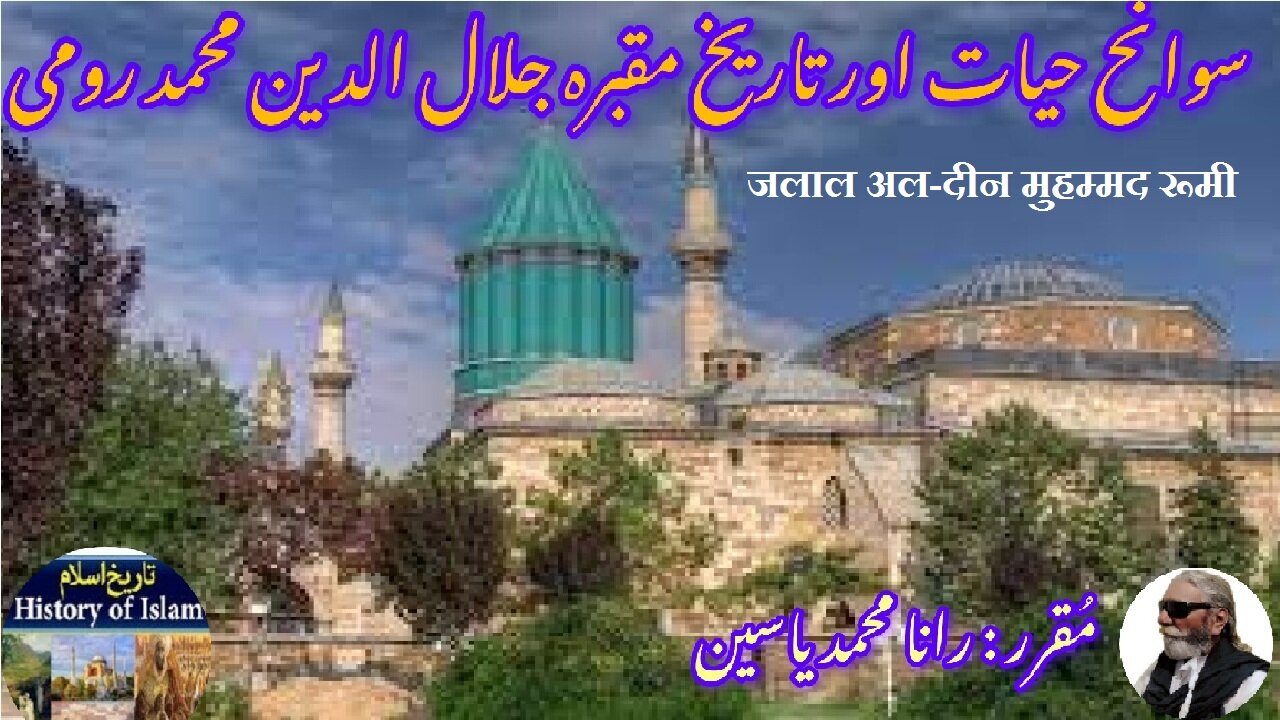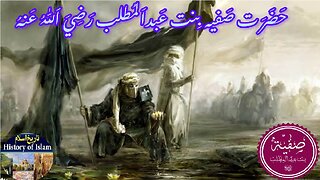Premium Only Content

Jalal al-Din Muhammad Rumi | जलाल अल-दीन रूमी | جلال الدین محمد رومی کی سوانح عمری اور مزار کی تاریخ
@islamichistory813 #biography #jalalaldin #muhammad #rumi #sufisaint #cultural #heritage #biography #islamic #mysticism #islamic #philosophy #shrine #historical #figures
Biography of Jalal al-Din Muhammad Rumi and the history of his shrine
Dekhti Aankhooon aur sountay kaanoon ko Asslamoalaikum, sisters, brothers friends and elders, in informative series videos of Islamic ascolars, sufisaints, cultural heritages, islamic philosophys, islamic mysticisms and historical figures. today we are describing biography of Jalal al-Din Muhammad Rumi and the history of his shrine.
Jalal al-Din Muhammad Rumi, more commonly known as Rumi, was born on September 30, 1207, in the city of Balkh, which is now located in present-day Afghanistan. He was born during the reign of the Khwarezmian Empire, a time of great cultural and intellectual flourishing in the Persian-speaking world. Rumi's early years were marked by a combination of academic learning, spiritual guidance, and profound personal experiences that would shape his eventual contributions to Sufism, literature, and philosophy. His father, Baha' Walad, was a respected scholar and theologian, and his mother, Mu'mina Khatun, was known for her piety and grace. Rumi's family fled from the Mongol invasions and eventually settled in Konya (modern-day Turkey), where Rumi would spend most of his life and produce his remarkable body of work.
Rumi’s intellectual and spiritual formation was deeply influenced by his father’s teachings. Baha' Walad, who was a well-versed scholar in Hanafi jurisprudence, theology, and Islamic mysticism, imparted the principles of Islamic scholarship to Rumi. After his father’s death, Rumi continued his studies under the guidance of various prominent teachers. During this period, Rumi came into contact with a number of great scholars, mystics, and thinkers, which would further shape his intellectual and spiritual path. Rumi was already highly skilled in Persian literature, Arabic grammar, and Islamic law by the time he was a young adult. However, his life took a transformative turn when he met the wandering dervish, Shams al-Din Tabrizi, who became his spiritual mentor and companion.
The encounter with Shams al-Din Tabrizi in 1244 marked a pivotal moment in Rumi’s life. Shams was a free-spirited and charismatic mystic who profoundly challenged Rumi’s conventional religious views and practices. The intense spiritual relationship between Rumi and Shams led Rumi to experience a deep inner transformation, marking the beginning of his journey into the mystical realms of Sufism. The impact of Shams on Rumi’s life cannot be overstated—he not only altered Rumi’s spiritual outlook but also inspired him to channel his newfound spiritual awareness into poetry. As a result, Rumi’s work took on a more mystical and transcendent nature, delving into themes of divine love, unity, and the search for closeness to God.
Rumi’s most famous and significant work, the *Mathnawi* (also known as the *Masnavi*), is considered one of the greatest literary achievements in Persian literature and is often referred to as the "spiritual Qur'an in Persian." Written in verse, the *Mathnawi* consists of six books of poetry and is filled with stories, parables, and moral lessons that explore the nature of love, devotion, and the soul’s yearning for God. The *Mathnawi* has been hailed as a timeless spiritual guide, addressing universal human themes and offering profound insights into the nature of the Divine and the path to spiritual enlightenment. Rumi’s poetry in the *Mathnawi* emphasizes the idea that the essence of true spirituality lies in the heart’s longing for union with the Divine, transcending the material world and ego. His work has had an enormous influence on the spiritual and literary traditions of not only the Persian-speaking world but also across the broader Islamic world and beyond.
Rumi’s influence extends far beyond the realm of poetry. He was a renowned Islamic scholar, a Hanafi jurist, and a Maturidi theologian. His deep understanding of Islamic law, theology, and philosophy informed his mystical views, and his teachings incorporated elements of both intellectual scholarship and spiritual insight. His Sufi teachings, centered around the idea of divine love and the search for spiritual union with God, continue to resonate with people of all backgrounds. The Mevlevi Order, commonly known as the Whirling Dervishes, was founded by Rumi’s followers after his death and remains one of the most well-known Sufi orders to this day. The Mevlevi’s iconic whirling dance is a symbolic act of spiritual ascension, representing the soul’s longing to reunite with the Divine.
Rumi's poetry, which was written mostly in Persian, also occasionally incorporated Turkish, Arabic, and Greek, reflecting his diverse cultural influences and his cosmopolitan upbringing. His work transcended national and ethnic boundaries, and his teachings were embraced by a wide range of people across the Muslim world. Rumi’s impact on Persian literature is immeasurable, and his works continue to inspire poets, philosophers, and spiritual seekers across the globe. His influence is particularly strong in languages such as Ottoman Turkish, Chughtai, Pashto, Kurdish, Urdu, and Bengali, where his themes of divine love, spiritual transformation, and the search for unity resonate deeply with local cultures and traditions.
Rumi’s impact extended far beyond his lifetime. He passed away on December 17, 1273, in Konya, where he had spent most of his life teaching, writing, and inspiring countless individuals. His tomb, located in Konya, has become a significant pilgrimage site for his followers and admirers. The Mevlana Museum, which houses his tomb, is one of the most visited cultural and religious sites in Turkey. The shrine itself is a stunning architectural landmark, featuring intricate tile work, calligraphy, and a serene atmosphere that reflects the spirit of Rumi’s teachings. The museum houses Rumi’s mausoleum, along with relics from his life and work, offering visitors a glimpse into the legacy of this extraordinary spiritual leader and poet.
The shrine of Rumi in Konya is not just a place of historical importance but also a symbol of the enduring power of his teachings. Every year, pilgrims and spiritual seekers gather at the tomb to pay homage to Rumi and to reflect on his profound messages of love, peace, and spiritual unity. The annual Whirling Dervishes Ceremony, held in Konya, is a central event during Rumi’s death anniversary, and it draws people from all over the world who are eager to witness the mystical dance that has become synonymous with his teachings.
In conclusion, Rumi's life, poetry, and spiritual teachings have left an indelible mark on the world. His works continue to inspire people of all cultures, ethnicities, and religious backgrounds, and his message of divine love, tolerance, and the unity of all humanity remains as relevant today as it was in the 13th century. His tomb in Konya, Turkey, stands as a testament to the enduring power of his teachings, attracting millions of pilgrims each year who seek to connect with his spiritual legacy. Rumi’s influence transcends national borders, ethnic divisions, and centuries, and his work remains a beacon of light for all those who are on a quest for deeper spiritual understanding and connection with the Divine.
With this, we seek your permission until tomorrow, tomorrow we will describe the biography of Saadi Shirazi and the history of his Shrine.
==========================
-
 29:41
29:41
ISLAMIC HISTORY
11 minutes agoHazrat Safiyyah (RA) | The brave women protector of Medina | حضرت صفیہؓ مدینہ کی بہادر خاتون محافظ
1 -
 1:06:17
1:06:17
Mike Rowe
17 hours agoThe Mastermind Behind THIS Radical Idea At WSU Tech | Sheree Utash #448 | The Way I Heard It
15K6 -
 LIVE
LIVE
GritsGG
55 minutes agoWin Streaking! Most Wins 3499+ 🧠
257 watching -
 DVR
DVR
Bannons War Room
6 months agoWarRoom Live
34.1M8K -
 LIVE
LIVE
ttvglamourx
50 minutes agoPLAYING WITH VIEWERS !DISCORD
114 watching -
 LIVE
LIVE
VapinGamers
1 hour agoTools of the Trade - Of Thumbnails and Titles, What's Important? - !rumbot !music
91 watching -
![Mr & Mrs X - [DS] Trafficking Empire – How Epstein Built His Web of Wealth and Deceit:Part 1 - Ep 5](https://1a-1791.com/video/fww1/f0/s8/1/o/k/J/d/okJdz.0kob-small-Mr-and-Mrs-X-DS-Trafficking.jpg) 52:11
52:11
X22 Report
2 hours agoMr & Mrs X - [DS] Trafficking Empire – How Epstein Built His Web of Wealth and Deceit:Part 1 - Ep 5
58.1K10 -
 1:13:18
1:13:18
Wendy Bell Radio
6 hours agoPet Talk With The Pet Doc
34.3K57 -
 LIVE
LIVE
dieseldesigns
5 hours agoExploring Labs In the DARK! // Abiotic factor
9 watching -
 LIVE
LIVE
BBQPenguin_
4 hours agoDragonball Z - The Android Saga
167 watching